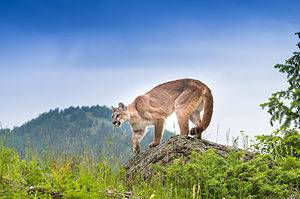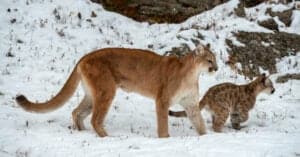Mountain lions are found throughout almost every ecosystem throughout America and are incredibly resilient, adapting to different environments with ease. They can reach speeds of up to 50 miles per hour, and their diet is strict: they only eat meat. So if you live or visit an area where mountain lions roam, it’s good to know what their tracks look like.
Mountain Lion Tracks
| Characteristics | Description |
|---|---|
| Size | 3 – 5 inches wide, depending on if male or female. |
| Features | Four asymmetrical toes (with one leading toe). Large palm pad. |
| Shape | Toes are shaped like teardrops. The palm pad is shaped like a trapezoid. |
| Claw Impressions | Rarely present but may narrowly appear. |
Animal Background
Mountain lions have several other names, with “puma” and “cougar” being two of the more common ones. They’re wide-ranging and can be found in North America down to South America. These solitary animals adapt easily to varying environments and situations, which is why they have survived the loss of their original habitats and continue to survive despite current threats. Mountain lions are strict carnivores, eating solely meat. Their prey animals include deer and elk, but they may eat other meat sources, including coyotes and raccoons.
Description
Mountain lions are between 7 and 8 feet long from their noses to the tips of their tails (the males are bigger than the females). The males can weigh up to 150 pounds, and their female counterparts typically weigh between 65 and 90 pounds. They may range in color from gray to tan. Mountain lion cubs’ bodies are often littered with blackish-brown spots.
Distribution
Mountain lions are found as far north as Canada and as far south as Chile. Generally, if deer inhabit the space, mountain lions are usually around. They enjoy mountainous terrain as well as rocky canyons and are comfortable both at sea level and up to 10,000 feet above sea level. They may also be found throughout coastal forests and even in desert environments. A male mountain lion’s home range may be quite large, spanning over 100 square miles, but females don’t roam that far out and are usually content with a home range anywhere between 20 and 60 square miles.
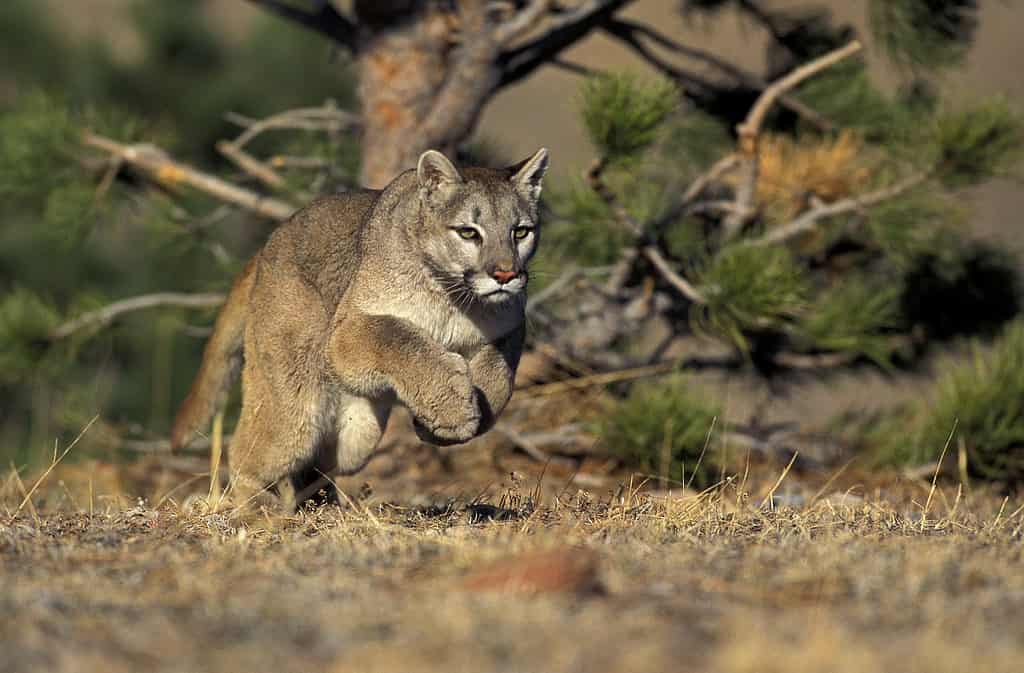
Mountain lions can reach 50 miles per hour in short bursts.
©iStock.com/slowmotiongli
Mountain Lion Tracks
Paw Morphology
A mountain lion has four toes and a heel pad, and together their shape is rounded (unlike a dog’s tracks, which are more oval-shaped). The toes of a mountain lion are asymmetrical, with the outside toe being significantly lower than the position of the other toes (think of it like your own pinky, which is shorter than your other fingers). Mountain lions have retractable claws, which is why they rarely show up in their tracks. However, they are more likely to appear in deeper substrates. The heel pad also has a distinguishing feature: there are three lobes on the backs of their heel pads and two in the front of their heel pads.
Snow
In the northern regions that mountain lions inhabit, like Canada, you will likely find their tracks in the snow. Even some residents of snowy Colorado have become adept at recognizing them. A mountain lion track is easy to distinguish when the snow is more compact. The palm pad leaves the three-lobed hind print as well as the two-lobed front print. When you look at the shape of the four toes, you can see that they are teardrop-shaped, and there are usually no claw marks. It’s significantly wider than it is long, and if you look at the space between the heel pad and the toes, it’s shaped like the letter “C.”
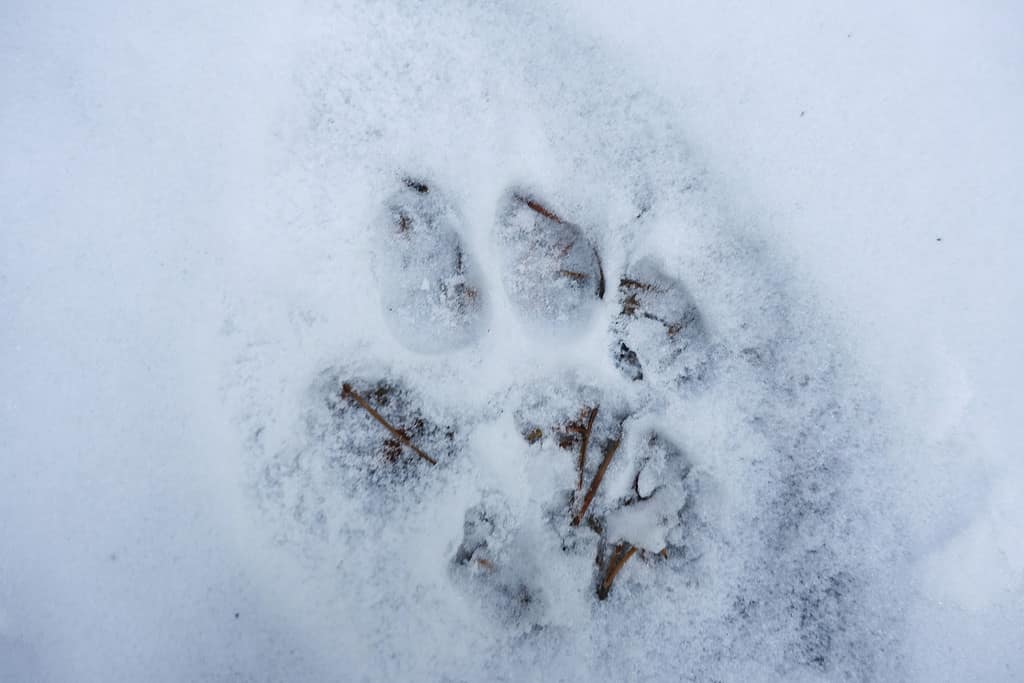
Mountain lion tracks in snow on a hiking trail in Canadian Rocky Mountains.
©Autumn Sky Photography/Shutterstock.com
Mud
In mud or soft soil, mountain lions may not be as distinct as they can be in the snow. However, one good indicator that it may be a mountain lion is the lack of claws in the print. Coyotes and domestic dogs nearly always leave visible claw prints behind. You can also distinguish a mountain lion’s tracks from a canine’s by looking for the leading toe — remember, their tracks are asymmetrical.
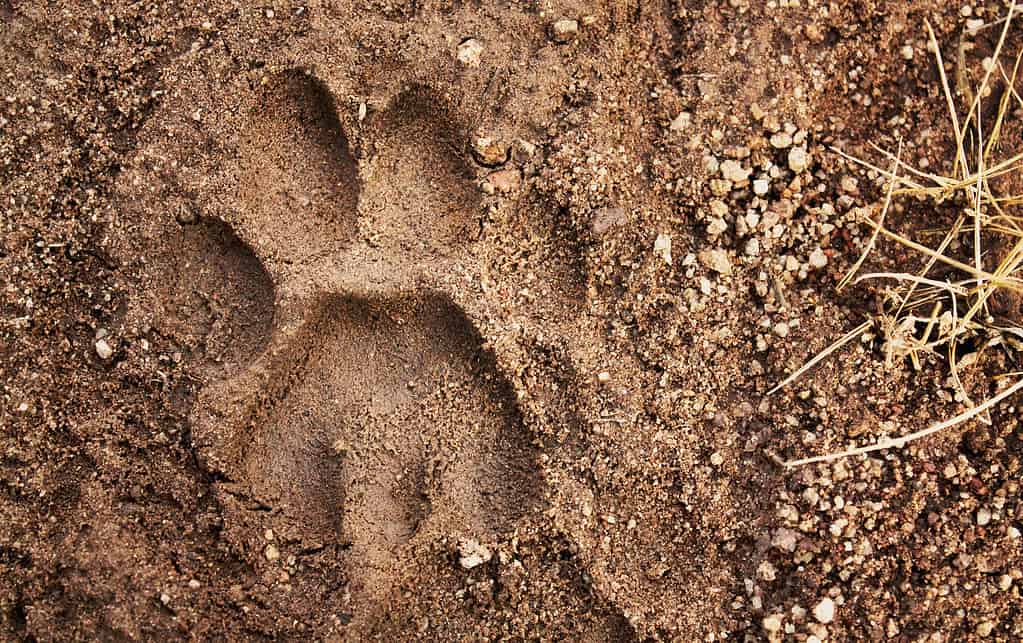
Mountain lion tracks in the Superstition Mountains of Arizona.
©pvjones/Shutterstock.com
Additional Tracking Tips
Scat
A mountain lion’s cat may be between six and 15 inches long with a one-inch diameter. It might be segmented in some cases, and in others, it may be a single, solid piece. There is usually a blunt end and a more pointed end. Since mountain lions are obligate carnivores, there won’t be remnants of berries. Rather, you may spot some bone, hair, and sometimes bits of grass. In addition, mountain lions may attempt to cover their scat, which means you may also notice some scraping on the ground next to the pile.
The photo featured at the top of this post is © Jim Cumming/Shutterstock.com
Thank you for reading! Have some feedback for us? Contact the AZ Animals editorial team.



